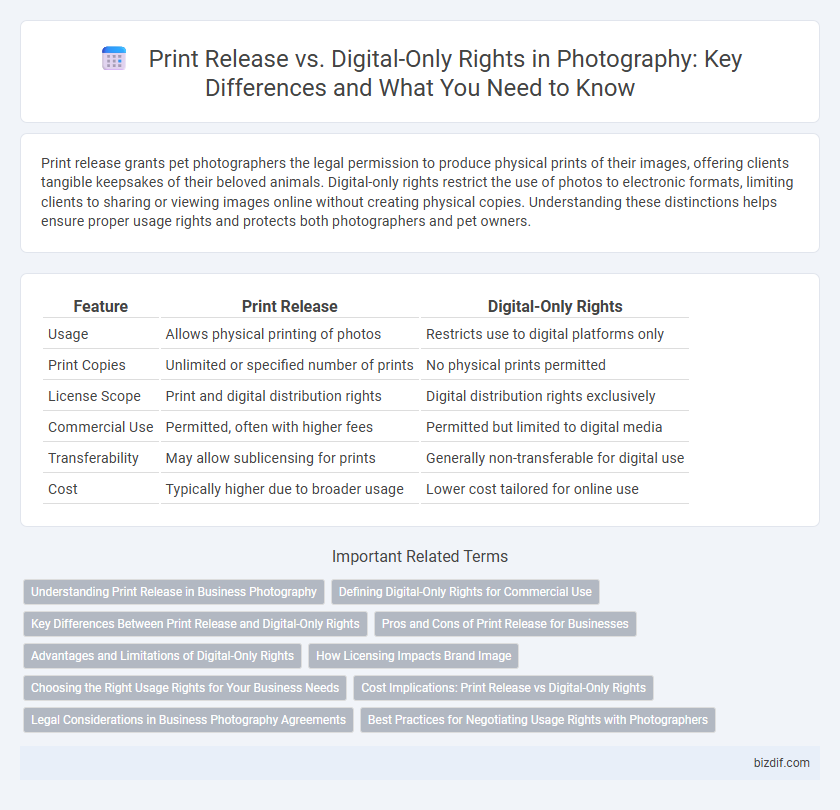Print release grants pet photographers the legal permission to produce physical prints of their images, offering clients tangible keepsakes of their beloved animals. Digital-only rights restrict the use of photos to electronic formats, limiting clients to sharing or viewing images online without creating physical copies. Understanding these distinctions helps ensure proper usage rights and protects both photographers and pet owners.
Table of Comparison
| Feature | Print Release | Digital-Only Rights |
|---|---|---|
| Usage | Allows physical printing of photos | Restricts use to digital platforms only |
| Print Copies | Unlimited or specified number of prints | No physical prints permitted |
| License Scope | Print and digital distribution rights | Digital distribution rights exclusively |
| Commercial Use | Permitted, often with higher fees | Permitted but limited to digital media |
| Transferability | May allow sublicensing for prints | Generally non-transferable for digital use |
| Cost | Typically higher due to broader usage | Lower cost tailored for online use |
Understanding Print Release in Business Photography
Print release in business photography grants clients the legal permission to reproduce and distribute physical copies of images, such as prints, posters, or marketing materials, without infringing copyright. This document specifies the scope, duration, and limitations of print usage, ensuring photographers maintain control over image reproduction while enabling clients to utilize visuals for branding or promotional purposes. Understanding the nuances of print release agreements helps photographers protect their intellectual property and clients avoid legal disputes in commercial projects.
Defining Digital-Only Rights for Commercial Use
Digital-only rights for commercial use grant clients permission to utilize photographic images exclusively in digital formats such as websites, social media, and digital advertising without allowing physical prints or reproductions. These rights are typically defined in licensing agreements to restrict usage to online platforms, ensuring the photographer retains control over print distribution and merchandising opportunities. Understanding digital-only rights helps businesses comply with copyright laws while maximizing online marketing potential through legally secured image usage.
Key Differences Between Print Release and Digital-Only Rights
Print release grants permission to reproduce photographs in physical formats such as magazines, posters, and merchandise, while digital-only rights restrict use to online platforms like websites and social media. Print releases often involve higher licensing fees due to the broader usage scope and potential for revenue generation from tangible products. Digital-only rights limit distribution channels and are typically more affordable, catering to clients focused solely on digital marketing and presentations.
Pros and Cons of Print Release for Businesses
Print release grants businesses the right to produce physical copies of photographs, enabling tangible marketing materials such as brochures and posters. This form of licensing enhances brand presence through high-quality prints while potentially increasing costs and logistical efforts compared to digital-only rights. However, print release limits the scope of distribution to physical formats, which may reduce flexibility in digital campaigns or online usage.
Advantages and Limitations of Digital-Only Rights
Digital-only rights in photography offer the advantage of instant distribution and global reach, enabling photographers to share images across online platforms without physical production costs. This licensing model limits the buyer's ability to reproduce images in print, restricting commercial print use and physical merchandising opportunities. While digital-only rights facilitate flexibility in online marketing, they can reduce potential revenue streams tied to printed products and physical media exposure.
How Licensing Impacts Brand Image
Print release licenses grant clients the ability to reproduce high-resolution images in physical formats, which can extend a brand's visibility through tangible marketing materials like brochures, posters, and packaging. Digital-only rights limit usage to online platforms, maintaining tighter control over image distribution but potentially restricting brand reach in offline channels. Licensing decisions influence how consistently and broadly a brand's visual identity is presented, impacting consumer perception and trust through the quality and longevity of image usage.
Choosing the Right Usage Rights for Your Business Needs
Selecting the appropriate usage rights between print release and digital-only rights depends on your business objectives and distribution channels. Print release rights grant clients the ability to produce physical copies, expanding revenue through tangible products like albums and wall art, while digital-only rights limit usage to online platforms, streamlining digital marketing and social media sharing. Carefully evaluating your target audience and intended content dissemination ensures optimal licensing agreements that align with your photography business goals.
Cost Implications: Print Release vs Digital-Only Rights
Print release rights typically involve higher costs due to the extended usage permissions allowing clients to reproduce photographs in physical formats such as books, magazines, or prints. Digital-only rights are generally more affordable, restricting usage to online platforms and digital media, thus limiting the scope for physical distribution. Photographers strategically price print releases higher to reflect the increased commercial value and potential multiple revenue streams from physical sales.
Legal Considerations in Business Photography Agreements
Print release grants clients permission to produce physical copies of photographs, while digital-only rights restrict usage to electronic platforms, impacting distribution and reproduction scopes. Legal considerations in business photography agreements must clearly define usage limits, licensing duration, and whether exclusivity applies to prevent unauthorized commercial exploitation. Properly drafted contracts reduce risks of copyright infringement disputes and ensure photographers retain control over their creative work.
Best Practices for Negotiating Usage Rights with Photographers
Negotiating usage rights with photographers requires clear understanding of print release versus digital-only rights to ensure proper licensing. Print release grants permission to reproduce images in physical formats like prints, albums, or wall art, while digital-only rights limit usage to online or electronic displays, such as websites and social media. Establishing precise terms in contracts, including scope, duration, and distribution channels, helps protect both parties and maximizes creative control.
Print Release vs Digital-Only Rights Infographic

 bizdif.com
bizdif.com